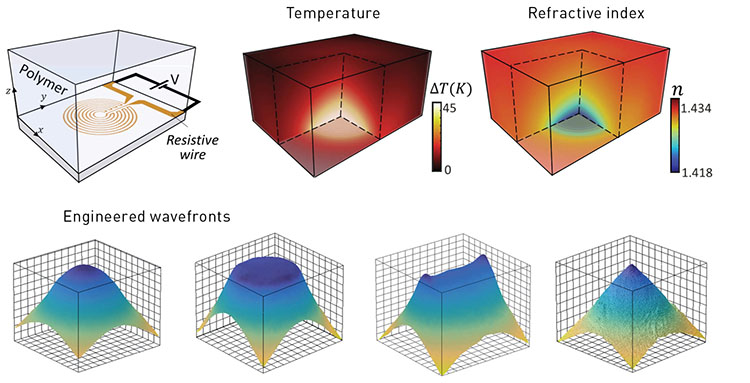 Top: An electrically controlled resistive heater in the tunable micro-optical device (left) induces variations in temperature (center) and, thus, refractive index (right) in a thermo-responsive material. The optimal resistor geometry for a desired wavefront shape can be determined via genetic-algorithm optimization. Bottom: Experimental wavefronts for (left to right) a defocus (diverging lens), flat profile (piston), vertical astigmatism (cylindrical lens) and conical surface (inverse axicon).
Top: An electrically controlled resistive heater in the tunable micro-optical device (left) induces variations in temperature (center) and, thus, refractive index (right) in a thermo-responsive material. The optimal resistor geometry for a desired wavefront shape can be determined via genetic-algorithm optimization. Bottom: Experimental wavefronts for (left to right) a defocus (diverging lens), flat profile (piston), vertical astigmatism (cylindrical lens) and conical surface (inverse axicon).
Integration of an adjustable zoom lens into a mm-thick mobile phone, a miniaturized microscope or the remote end of a medical endoscope requires complex optics that can be reshaped electrically within milliseconds. While liquid-crystal spatial light modulators are the tool of choice for high-resolution wavefront shaping, their polarization sensitivity, chromaticity, cost and size limit their applications outside of the optics lab.
We have recently demonstrated quasi-achromatic, polarization-insensitive electrical components that can apply predetermined, continuous local wavefront shaping with unprecedented degrees of freedom at the microscale—without any mechanical movement.1 In this approach, which we call Smartlens, a current is passed through a well-optimized micrometer-scale resistor. The heating locally changes the refractive-index distribution of the transparent polymer plate surrounding the resistor. Much as a mirage bends light passing through hot air to create the illusion of distant lakes, this microscale hot region can precisely deviate light. The small, micrometer-scale Smartlenses heat up and cool down quickly; within milliseconds, a simple slab of polymer can be turned into a lens and back.
Since Smartlenses can be fabricated in arrays, we were able to demonstrate that several colored objects located at very different distances can be simultaneously brought into focus on a camera sensor by activating the Smartlenses located in front of each of them, owing to the relatively low chromaticity of most thermo-optical coefficients.
Furthermore, by modeling the heat diffusion and light propagation, and optimizing with a genetic algorithm, we showed that this approach can go way beyond simple lenses. Indeed, a properly engineered resistor can shape light with a high level of control and achieve a broad range of optical functions, including astigmatism, axicons or freeform shaping—for example, to dynamically correct the aberrations of an optical instrument.
Remarkably, the Smartlens technology is very compact, cost-effective and scalable. We believe it has the potential to be applied to high-end technological systems as well as simple end-user-oriented imaging devices, and could have a substantial impact on current integrated optical systems.
Researchers
Pascal Berto Université Paris Descartes, Paris, France
Gilles Tessier, Sorbonne Université, Institut de la Vision, Paris, France
Romain Quidant, ICFO–Institut de Ciències Fotòniques and ICREA–Institució Catalana de Recerca i Estudis Avançats, Barcelona, Spain, and ETH Zurich, Switzerland
References
1. P. Berto et al. Nat. Photon 13, 649 (2019).
